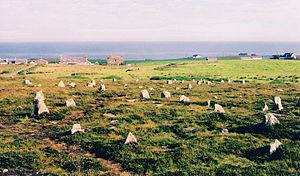Hill O Many Stanes

The Hill O Many Stanes is a south-facing hillside (at ND295384) in Caithness, in the parish of Mid Clyth, about nine miles south of the county town, Wick.
Across the hillside are about 200 upright stones, none more than three feet high, set out in rows running approximately north and south with the incline. The rows are not parallel, however, and they create a fan-shaped pattern. This arrangement is believed to be a relic of Bronze Age times.
From the northern end of the rows, on a clear day, hills along the coast of Banffshire can be seen across the Moray Firth, some fifty miles away. If the night sky is clear the moon in its most southerly rising position will be seen over those same hills.
Alexander Thom (a popular if discredited scholar of megalithic sites) claimed in his Megalithic Lunar Observatories[1] that the stone rows were in effect a Bronze Age lunar observatory, tracking lunar movements over a cycle of 18.6 years. However, more than twenty similar stone rows are now known in Caithness and Sutherland and none of the others has been linked with astronomical observations.
In Britain stone rows of this kind are unknown outside Caithness and Sutherland, but similar rows of much taller stones are found in Brittany.
Outside links
- Location map: 58°19’42"N, 3°12’20"W
- Streetmap: ND295384
References
- ↑ Alexander Thom: Megalithic Lunar Observatories, Oxford University Press, 1971